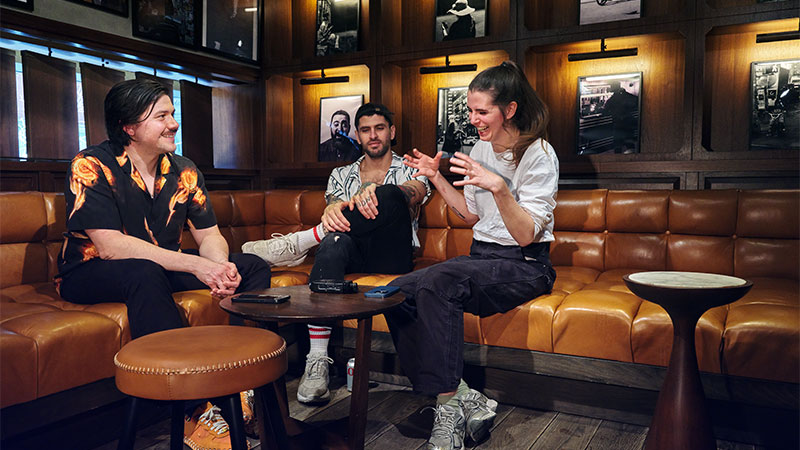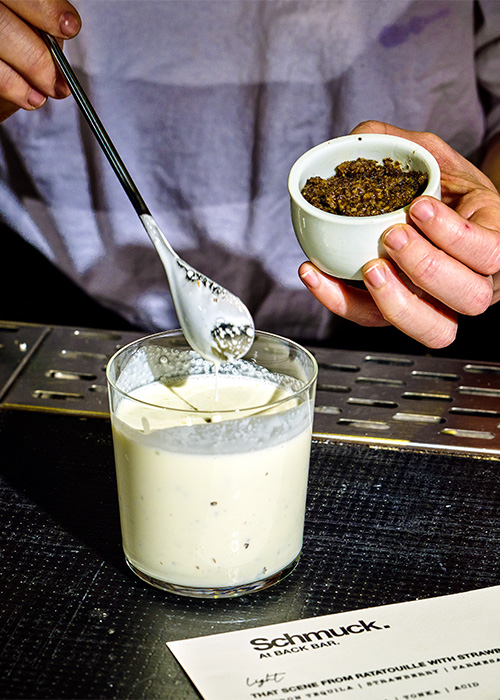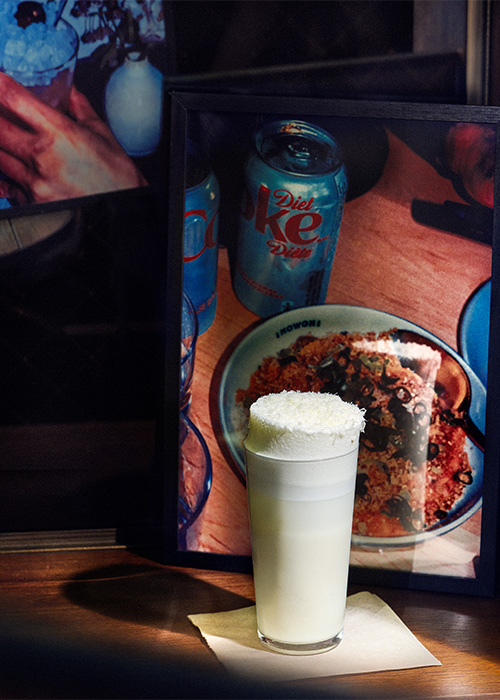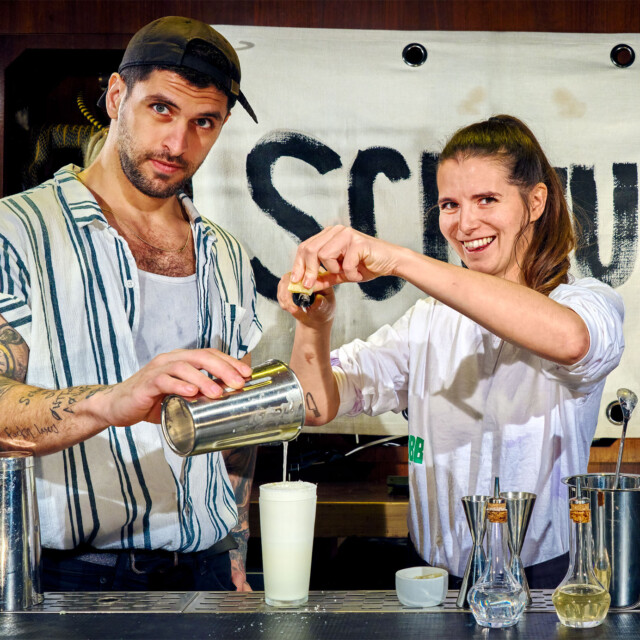It happens a couple times a week to just about every cocktail bartender. The bar is buzzing, tickets are flowing, and your hands are moving faster than your brain. The drinks are just happening, appearing in front of you as if by magic. Most guests are engrossed in conversation or savoring a first or second round, but a few will stop and just watch. Then comes the inevitable question: “How do you remember all those drinks?”
Most drink recipes are actually very simple and tend to follow a few common ratios. Once you know a few classics, a whole world of cocktails is unlocked. In last month’s “Techniques!” we explored the “Potato Head” style of mixology, and how the Shinji’s bar team uses it to breathe new life into familiar formulas. Shinji’s takes this approach to the limit by making their own bespoke liqueurs, leading to new and unique takes on drinks like the Vesper and Last Word.
In truth, anyone can swap an ingredient to transform an existing drink into one of their own creation. There is, however, another much more difficult path for bartenders to take — one that shifts cocktail ideation from behind the bar and into the kitchen.
From Dish to Drink
Culinary-inspired cocktails are not a new trend — just look to modern classics like Don Lee’s “Benton’s Old Fashioned” that served breakfast in a glass and launched the fat washing technique all the way back in 2007, at PDT, or his buttered popcorn rum and Coke the “Cinema Highball” from the same era.
Despite relatively long standing as a conceptual framework, there’s a good reason these food-to-drink concoctions don’t feature on every menu, and why many examples that we do see are unsuccessful also-rans: It’s remarkably difficult to get them right. Creating a dish in drink form is a delicate balancing act, and it’s all too easy to end up with a coupe full of soup instead of a deliciously savory cocktail.
Enter: Schmuck. At the season’s hottest NYC pop-up — with a full brick and mortar coming later this year — Juliette Larrouy and Moe Aljaff are coming in hot, and encouraging you to drink your dinner.
Moe and Juliette’s varied backgrounds and experiences make them the perfect duo to create culinary cocktails. Juliette grew up in Nice, cooking with her parents and grandparents; trained at culinary school; then moved to Paris to work in kitchens at some of the city’s top restaurants, honing her savory and pastry chops. Moe left Sweden at 18 to travel the world, living in India, Thailand, Amsterdam, and eventually Spain, where he perfected the fun, playful, raucous side of hospitality in dive bars. He waxes poetic about a bar manager early in his career who inscribed three crucial words deep in his cerebral cortex: “Flavor is king.”
The duo eventually joined forces at “cocktail dive” Two Schmucks in Barcelona and took the cocktail world by storm, securing the No. 7 spot on the World’s 50 Best list in 2022. Though they left shortly after, Moe and Juliette continue to focus on playful, thoughtful cocktails like “Melon, Cheese, and Pepper,” which marries an acidulated cantaloupe cordial with gin, mozzarella foam, and fresh cracked pepper. It reads completely incongruous for a drink — one that has no business being delicious at all — but the flavors and textures are completely dialed in, creating a drinking experience as fun as it is balanced.
Culinary Cocktails in Practice
So how do these ideas go from Juliette’s prolific Notes app list of flavor ideas to cocktails? I sat down with the duo at Backbar at the Kimpton Hotel Eventi, home of the Schmuck pop-up, to find out. (I also got a sneak peek at that Notes app: Anchovy is at the top of the list so be on the lookout for something fishy coming soon!)

Juliette began by shaking up a “Ramos Royale” from the menu, and explained how the drink went from concept to Collins glass. The drink is inspired by a mid-course nibble at a multi-Michelin-star Paris tasting menu, which featured a sliver of fragrant porcini mushroom with white chocolate that was equally tasty and unexpected. The Schmuck partners love a Ramos Gin Fizz because of its classic flavor profile and the showmanship of its service, so the question became how to include these new flavors in the timeless cocktail.
“Creamy, clarified, fizzy — all of these different textures need a different technique.”
The first ingredient to solve was the white chocolate. “White chocolate is just cacao butter, sugar, and milk,” Juliette explains. To add those flavors, it’s not actually necessary to include white chocolate, which is “really intense” in a drink. She opts instead to fat wash the base spirit (gin) with cacao butter, then incorporate milk and sugar in the form of simple syrup and cream. Every component is present but in a way that serves the drink rather than the ingredient.
Next stop was mushroom. Juliette’s experience has taught her that dairy is an ideal carrier for mushroom flavor, so she stirs black truffle paste directly into the cream, lending it an earthy funk. The flavor-charged gin and cream are shaken into a Ramos Fizz and topped with freshly grated parm for one last blast of salt and umami. Once more, it shouldn’t work as a cocktail, but I found myself sipping again and again, with a big cheesy milk mustache and wide grin plastered on my face.
The Schmucks continued hitting me fast and furious with more examples of food items turned into drinks. Moe went into depth on the “Curry Colada,” a cocktail that leans on the “incredibly bold and spicy” flavors he experienced during his time in India and Thailand. “A clarified milk punch was great because it’s like, ‘How do we leave the spice there but tone it way the hell down and make it smooth and nice and easygoing to drink?’” he says.

Juliette explains how they translated the classic Tarte Tatin pastry into a complex and balanced concoction. Figuring the pastry crust would be a straight infusion, to my surprise, Juliette avoids adding any cooked, gluten-rich ingredients to her recipes. Instead, she combines a butter-fat-washed Cognac with sugar and amontillado sherry to provide the nuttiness and richness of a baked crust, then shakes with cooked apple juice and crème fraiche. The result is a delicious, ethereal cocktail that tastes like it somehow just came out of your grandmother’s oven.
I pressed them for a through line to their ideation process — are there any “universal” techniques for specific ingredients to make these drinks easier to break apart and rebuild at home or replicate on other bar programs?
The short answer is a resounding “no” and the long answer is “it depends.”
Making Great Drinks — Culinary or Otherwise
Ultimately, the Schmuck Method starts stylistically. “Creamy, clarified, fizzy — all of these different textures need a different technique,” Juliette says. They build out the menu then apply various ideas to different menu slots — boozy and stirred, light and refreshing, etc. No single technical application works every time, and some ideas take almost a full decade to come to fruition.
For example, Moe has worked on “That Scene From Ratatouille With Strawberry and Cheese” — literally a strawberry and cheese cocktail inspired by that scene from the Pixar classic — since 2016. Here’s how the process went over the past eight years: “Failed miserably. I left it. I came back to it. I failed. I left it. I came back to it. I failed. I left it,” he says. It wasn’t until he arrived in New York and found Parmesan Cheese Powder at the bartender Mecca for outsider ingredients, Kalustyans, that he realized it could finally work. The final cocktail is clarified, carbonated, and now one of the most popular drinks at the pop-up.
“I prefer my team to always taste a thousand times,” so that if they forget a drop of salt “they can feel it.”
It was my sincere hope to chat with Moe and Juliette and come away with a “cheat sheet” of sorts, a CliffNotes version of their years of hard work that I could distill into a few paragraphs so you could start making macaroni and cheese or blueberry pie cocktails. But unfortunately, it’s not so simple. Without access to the array of ingredients of a professional bar and kitchen, and dedicated time to devote to pointed R&D, it’s like shooting an arrow blindfolded at a target a hundred meters away against the wind.

And even with all the professional-grade gear, the drinks are remarkably difficult to get right. I spent an abysmal few hours on a “Garden Salad” cocktail before I realized the following: a) It’s a terrible idea, and b) I’m tired of pouring rhum agricole, highland tequila, and good sherry vinegar down the drain. These cocktails simply can’t be plucked out of thin air the way “Potato Head” drinks can. They take making, and testing, and scrapping, and drawing up again and again and again. All of which is no doubt out of the wheelhouse of the vast majority of home bartenders.
That said, the Schmucks left me with some brilliant advice for the amateur bartender or seasoned mixologist looking to take a different approach.
The first and most important pointer is to taste everything, all the time. Each time you make a cocktail, taste every component before you add it to the shaker, then taste the combined ingredients at room temp before you shake or stir. Be aware of exactly how fresh all your ingredients are, and how that’s going to affect the drink. “This is the way of the kitchen. You taste everything you send,” Juliette says. “People make fun of me — guests, or even my team, like, ‘Oh, you smell and you taste everything.’”
She’s laughing as she says this, and it might be funny, but it’s also smart and purposeful.
“Cocktails are basically a language. Once you’ve tried everything and you’ve tried it again, that’s you learning the words.”
With just gin and vermouth, a Martini is going to be ruined if the vermouth has been open in a cabinet for a year. Similarly, it doesn’t matter if your ingredients are exact to the gram or milliliter if the cordial from two days ago has a drop-off in flavor after 36 hours. “I prefer my team to always taste a thousand times,” so that if they forget a drop of salt “they can feel it,” Juliette says.
The next piece of advice seems excessive but is absolutely necessary to guarantee a great cocktail in your glass. Every drink at Schmuck goes through a rigorous checklist once they believe it’s menu-ready. Moe lays out the steps: “We taste it and it’s good, then we leave it for a while, then we taste it again.” The five or so minutes of waiting is critical, he explains, because it simulates the reality of the guest experience. The drink still has to be delicious even when it’s not fresh from the bar.
At Booker and Dax and Existing Conditions we had the “15-minute rule” — same concept, with time extended — so I can confirm this to be true. Some delicious drinks just aren’t fit for service because bartenders have no control over how long guests will take to drink them.
The final step of the Schmuck’s checklist is to finish tasting the cocktail and carefully evaluate its conclusion. Moe’s nightmare scenario is that a guest will linger over a cocktail that they enjoyed for a while, but “their last memory will be that last sip of the cocktail when they found it to be too sweet or too heavy.” The entire lifespan of every cocktail should be determined as delicious, before it’s ever served to a guest.
The last thing I want to leave you with is some philosophy from Moe, because I certainly won’t share my terrible salad recipe: “Cocktails are basically a language. Once you’ve tried everything and you’ve tried it again, that’s you learning the words,” he says. “And then you learn to slowly put together sentences, and then at a certain point you just know how to speak it.”
Luckily, while you’re still hammering away at your first thousand, Juliette and Moe will be hard at work, tinkering away at drinks for their next pop-up, or the opening menu of their new bar. I, for one, can’t wait to see what they do next.
This story is a part of VP Pro, our free platform and newsletter for drinks industry professionals, covering wine, beer, liquor, and beyond. Sign up for VP Pro now!
